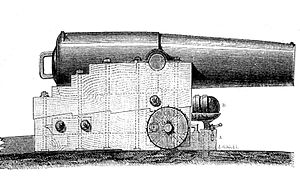| Paixhans gun (Canon Paixhans) | |
|---|---|
 Paixhans naval shell gun. Musée de la Marine. | |
| Type | Naval artillery |
| Place of origin | France |
| Service history | |
| Used by | France, the United States, Russia |
| Wars | Second Opium War, Anglo-French blockade of the Río de la Plata, Mexican–American War, Second Schleswig War, Crimean War, American Civil War |
| Production history | |
| Designer | Henri-Joseph Paixhans |
| Designed | 1823 |
| Specifications | |
| Mass | 3,400 kg (7,500 lb) |
| Length | 2.85 m (9.4 ft) [1] |
| Shell | 30 kg (66 lb) shell |
| Caliber | 220 mm (8.7 in)[1] |
| Muzzle velocity | 400 m/s (1,300 ft/s) |
The Paixhans gun (French: Canon Paixhans, French pronunciation: [pɛksɑ̃]) was the first naval gun designed to fire explosive shells. It was developed by the French general Henri-Joseph Paixhans in 1822–1823. The design furthered the evolution of naval artillery into the modern age. Its use presaged the end of wood as the preferred material in naval warships, and the rise of the ironclad.
Explosive shells had been used in ground warfare and against stationary targets, but not in high-velocity, flat-trajectory guns due to safety concerns. Henri-Joseph Paixhans developed a delaying mechanism that allowed explosive shells to be safely fired in high-powered guns, first demonstrated in trials in 1824. The French Navy adopted the first Paixhans guns in 1841, and the weapons eventually saw use in the 1840s by France, Britain, Russia, and the United States. The guns' effectiveness in naval combat was demonstrated in battles such as Veracruz in 1838, Campeche in 1843, and Sinop in 1853.
Although the idea was innovative, metallurgy at the time had not advanced enough for safe operation, leading to catastrophic failures in naval guns. Further developments by John A. Dahlgren and Thomas Jackson Rodman improved the weapon for both solid shot and shell use.